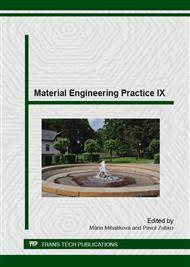p.100
p.106
p.112
p.118
p.122
p.127
p.131
p.135
p.139
Microstructure of Agglomerate Produced with Charcoal as Substitution Fuel
Abstract:
Worldwide laboratory research proves that replacement of coke breeze by solid biomass in the process of agglomeration is possible [1,2,3]. One possibility of solid biomass use is the charcoal. Literature indicates that coke breeze can be replaced by charcoal up to 40% based on calorific value [4]. This paper deals with the poblems of coke breeze substitution by charcoal in laboratory conditions sintering and the impact of such substitution on the resulting agglomerate properties, i.e. microstructure. Agglomerate microstructure consists of mineralogical phases; hematite, magnetite, calcium and aluminum silico-ferrites, and silicates. Substituting coke breeze for charcoal up to 40% in the process of agglomeration, slight changes occur in the volume fractions of individual phases of the agglomerates. Volume fractions of agglomerate phases change significantly above 40% substitution by charcoal. Phase composition has an effect on the quality characteristics of the produced agglomerate. The amount of calcium and aluminum silico-ferrites influences the strength of the agglomerate [5].
Info:
Periodical:
Pages:
122-126
Citation:
Online since:
December 2014
Authors:
Price:
Сopyright:
© 2015 Trans Tech Publications Ltd. All Rights Reserved
Share:
Citation:


